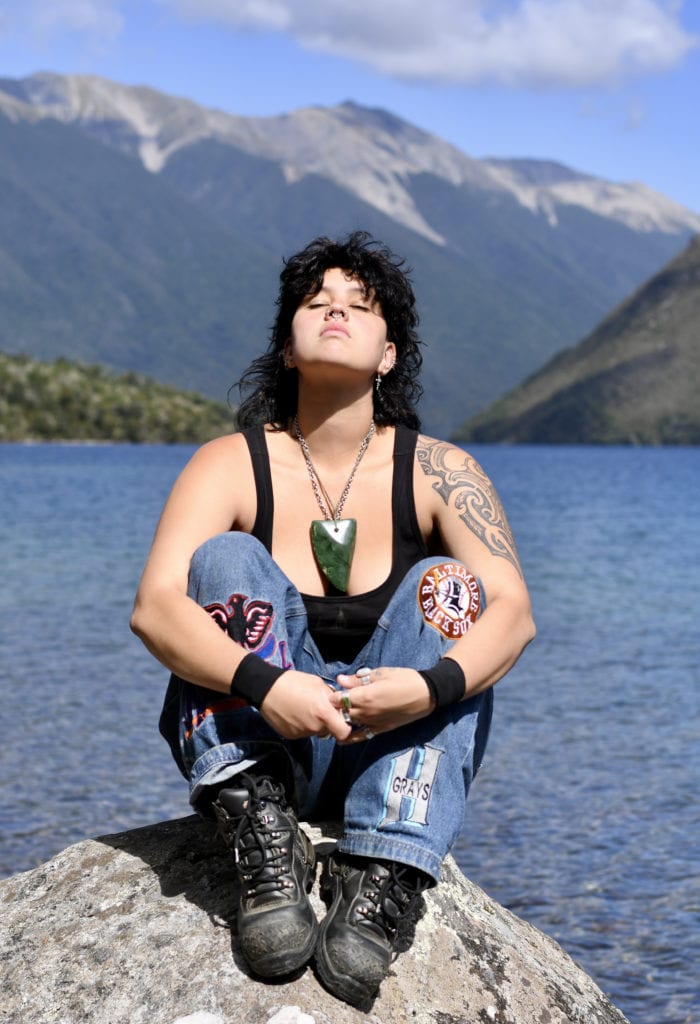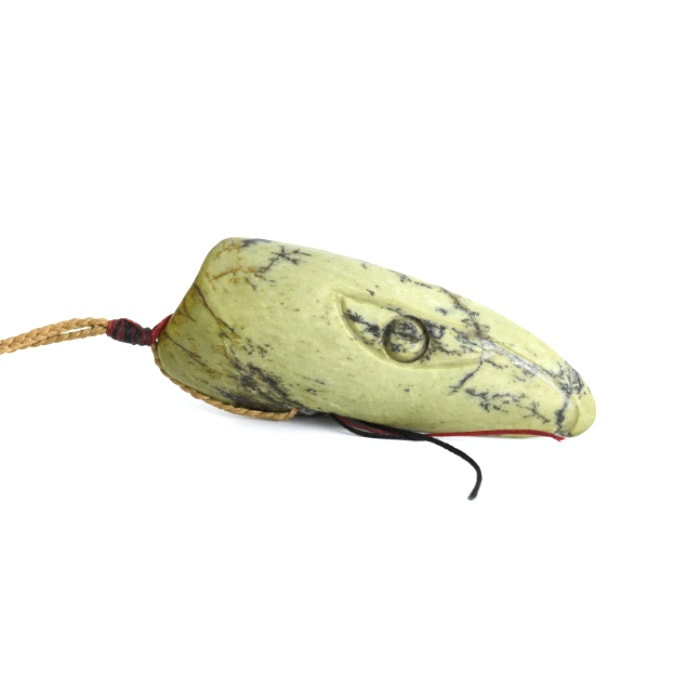When Tim first started carving pounamu he loved to carve these massive taonga, and I mean massive! I couldn’t understand it. In my mind pounamu taonga were beautiful and small, something you could pop down your shirt and go about your business with. Tim’s large pounamu taonga were like the size of bread and butter plates, and could potentially knock you out if you ran with them!
I would ask Tim, who’s going to wear those? His reply, “me, I would, I do”. And indeed he did.
Of course, you know how it is when your attention is brought to something new and you begin to see that thing everywhere? Well, I began to see large pounamu taonga everywhere. This wahine on a documentary was wearing a tiki that covered almost the entire top half of her chest. It must have weighed almost a kg! We met this lovely tāne at McDonald’s wearing a taonga that was 5-6cm across the top and easily 30cm long. Just rocking his giant taonga whilst treating his tamariki to breakfast at McDonald’s. Turned out his taonga was a slice from a pounamu kohatu his nanny had given the whānau. As I attended more hui and tangihanga I saw more and more of these nui pounamu taonga that made Tim’s large taonga look small in comparison!
I was beginning to see it was a thing. And the more I saw Māori interact and engage with the pounamu I began to understand why. You see, if you don’t know this, for Māori pounamu is so much more than a pretty stone of cultural and historical significance. Pounamu has its own wairua, mana and mauri. It carries your tupuna and your tipuna, as well as yourself. Pounamu protects and guides, strengthens and soothes, it energises and brings peace. I’ve seen tough gang members cry as they receive their first pounamu taonga, holding on to that taonga as if it is their life. I’ve been honoured to be part of many taonga giftings and seen the way taonga can make a person lift their head, pull back their shoulders and laugh or cry or beam with joy. Pounamu does something to people. Especially Māori. And that’s what Mana Taonga are all about.
So when Tim brought me in all his latest creations for the website I didn’t bat an eye at the size of them and the only patai I asked were the ones following;
Can you tell me why you make Mana Taonga and what they mean to you?
When I cut a stone, usually the first cut I allow enough stone just in case it’s going to be outstanding and (that first cut) it has the kiri left on it. So they are beautiful pieces that carry all the wairua of the kohatu and retain their original form.
When the stone falls open for the very first time and you see inside it, you realise that that first piece has to be made into something that captures the wairua of that first glimpse. You know, it’s like meeting your wife for the very first time, every day. Like 50 first dates, you know, every stone has that same effect. And what I try to capture in Mana Taonga is that moment of first contact, of first sight, when you see the beauty in the stone and when you make a piece from that initial contact. It holds all of that wairua, all of those feelings, all of that visual look. And when you hold it you feel the same, every time you hold it and pick it up.
And what is the feeling?
Of reverence. Reverence to something inert, yet so beautiful that there aren’t words to describe it. I don’t think all the libraries in the world could describe the feelings that are housed in that initial moment of contact.
So all the mana taonga are only made out of the first cut?
No, no. Sometimes the first cut has too many fractures in it, even when I try to cut it not that way. But within the stone, pretty quickly I’ll isolate parts of the stone that have either pictures or when you look at it, holding it in your hand you can immediately see a story there. They are pieces that capture the wairua and the beauty of the kohatu.
And what do you want other people to feel when they are given a Mana Taonga?
That same feeling, that same feeling of meeting their partner for the first time. That same feeling of feasting their eyes on their firstborn child. Those same feelings that you get when being out in nature. Just overwhelming joy and aroha. Awe and reverence.
How do you want them to feel when they wear it?
I don’t think I want the people to feel anything, I just want them to be in sync with the taonga, to be in the now with it. To wear it and almost forget it’s on, that it becomes a part of you. You just know that you have your taonga, your tupuna, with you.
It’s just about people enjoying and embracing the taonga?
Yes, and the stone allows itself to be enjoyed. Because you think of it, when I find my stone and then bring it back and carve it and then gift it on, you know that might have taken a week or it might have taken a year. In some cases, I’ve had taonga on my bench for 2,3,4 years before they are finished because having them in my workshop means that I keep that mana with me that each piece has. To let them go is a hard thing, but a good thing because then I know that other people will get that same sense of feeling and connection.
So it’s more that, you know, when we’re dead buried and gone the mana of the stone is still there, the mana of the taonga is still there. And the mana of the person who originally wore it and owned it and has now passed on, that mana has been captured by the piece and is held in there forever too. You know 10, 20, 30 million years down the road. It will still be there, captured in the stone. Its mana once again has taken on a different aspect, a different facet.
So pounamu is a stone that can carry you?
Oh totally. Gosh. People go on about all stones and absolutely all stones have mana all stone has wairua. Each stone has an atua that they are a family of. Pounamu is in its unique category in that it’s the heart of a star and it’s the tear of a god. Not a god but The god. You know, Papātuānuku and Ranginui. Well, when Ranginui cried those tears they fell to Papatūānuku and turned into solid gems of wairua called Tangiwai. And Tangiwai is only found in Aotearoa. Bowenite is found in other places, but not Tangiwai. So when you wear the heart of a star or the tear of The god, it just changes everything. It changes how you stand, how you feel, how you look and how you conduct yourself.
And that’s what Mana Taonga are about.



Amazing beautiful story and information all New Zealanders should know the beauty of our culture, and in that knowledge you become part of the land, this knowledge is denied to many New Zealanders through past and present Goverments, we can get this knowledge to the people through making it compulsory in our schools and then the people will one day be united and see the light
Kia ora Velda, thanks for being part of the discussion. Āe, progress is being made and a future of unity is definitely something Tim and I are working for. Appreciate your input.